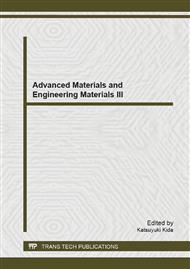[1]
R.K. Paramaguru, R.K. Gagali, H.S. Ray, Influence of Slag and Foam Characteristic on Reduction of FeO Containing Slags by Solid Carbon, Met. Mater Trans B. 28B(1997) 805-810.
DOI: 10.1007/s11663-997-0007-5
Google Scholar
[2]
I. Sohn, R.J. Fruehan, The Reduction of Iron Oxide by Volatiles in a Rotary Hearth Furnace Process Part I – The Role and Kinetics of Volatile Reduction, Met Mater Trans B. 36(2005) 605-612.
DOI: 10.1007/s11663-005-0051-y
Google Scholar
[3]
J. W. Soedarsono, A. Kawigraha, R.D. Sulamet-Ariobimo, D. Johansyah, G.D. Kusuma, Suprayogi, A. Yosi, N.L. Saputro, A.T. Sidiq, Erwin, and D. Natanael, Potential Indonesia Ores as Raw Material for Producing Iron Nugget, AMR. 652-654(2012).
DOI: 10.4028/www.scientific.net/amr.652-654.2529
Google Scholar
[4]
J. W. Soedarsono, V. Astini, F. Fazri, A. Kawigraha, R.D. Sulamet-Ariobimo, A. Rustandi, and S. Tjahyono: submitted to ICMEMM (2013).
DOI: 10.4028/www.scientific.net/amr.887-888.281
Google Scholar
[5]
A. Kawigraha, S. Harjanto, J.W. Soedarsono, and Pramusanto, Reduction Behaviour of Coal Composite Pellet made from Indonesia Low Grade Iron Ore, unpublished.
DOI: 10.4028/www.scientific.net/amm.281.490
Google Scholar
[6]
A. Kawigraha, J.W. Soedarsono, S. Harjanto, Pramusanto, Reduction of Composite Pellet Containing Indonesia Lateritic Iron Ore as Raw Material for Producing TWDI, AMM. 281 (2013) 490-495.
DOI: 10.4028/www.scientific.net/amm.281.490
Google Scholar
[7]
K. Mondal, H. Lorethova, E. Hippo, T. Wiltowski, S.B. Lalvani, Reduction of Iron Oxide in Carbon Monoxide Atmosphere – Reaction Controlled Kinetics, Fuel Process Technol. 86(2004) 33-47.
DOI: 10.1016/j.fuproc.2003.12.009
Google Scholar
[8]
T. Usui, N. Inoue, T. Watanabe, T. Yokoyama, T. Oyama, M. Morita, Pre Reduction of Iron Oxide with Coal Carbonization Gas, Ironmak Steelmak. 31(2004) 479–484.
DOI: 10.1179/030192304225019289
Google Scholar
[9]
N. Ishikawa, K. Furuya, N. Mitsuoka, T. Inami, Reduction Wustite by Solid Carbon, ISIJ Int. 46(2006) 1106–1107.
DOI: 10.2355/isijinternational.46.1106
Google Scholar
[10]
R. Haque, H.S. Ray, Role of Ore/Carbon Contact and Direct Reduction in the Reduction of Iron Oxide by Carbon, Met Mater Trans B. 26B(1995) 400-401.
DOI: 10.1007/bf02660982
Google Scholar
[11]
S.K. Dey, B. Jana, A. Basumallick, Kinetics and Reduction Characteristics of Hematite-Non Cooking Coal Mixed Pellets under Nitrogen Gas Atmosphere, ISIJ Int. 33(1993) 735-739.
DOI: 10.2355/isijinternational.33.735
Google Scholar
[12]
Q. Wang, Z. Yang, J. Tian, W. Li, J Sun, Mechanism of Reduction in Iron Ore – Coal Composite Pellets, Ironmak Steelmak. 24(1997) 457-60.
Google Scholar
[13]
T. Yamashita, T. Nakada, K. Nagata, In-situ Observation of Fe0. 94O Reduction at High Temperature with the Use of Optical Microscopy, Met Mater Trans B. 38B(2007) 185-191.
DOI: 10.1007/s11663-007-9039-0
Google Scholar
[14]
A.E.A. Nogueira, M.B. Mourao, C. Takano, D. M. Santos, Effect of Slag Composition on Iron Nuggets Formation from Carbon Composite Pellets, Mater Res. 13-2(2010) 191-195.
DOI: 10.1590/s1516-14392010000200012
Google Scholar
[15]
B. Anameric, K.B. Rundman, S.K. Kawatra, Carburization Effects on Pig Iron Nugget Making, Miner Metal Proc. 23-3(2006) 139-150.
DOI: 10.1007/bf03403201
Google Scholar
[16]
J. Moon, V. Sahajwalla, Investigation into the Role of the Bouduard Reaction in Self Reducing Iron Oxide and Carbon Briquettes, Met Mater Trans B. 37B(2006) 215-221.
DOI: 10.1007/bf02693151
Google Scholar
[17]
E. Donskoi, D.L.S. Mc Elwain, L.J. Wibbrley, Estimation and Modelling of Parameter for Direct Reduction in Iron Ore/Coal Composites Part II - Kinetic Parameter, Met Mater Trans B. 34B(2003) 255-266.
DOI: 10.1007/s11663-003-0012-2
Google Scholar
[18]
I. Kobayashi, Y. Tanigaki, A. Uragami, A New Process to Produce Iron Directly from Fine Ore and Coal, Iron and Steelmaker. 28-9(2001) 19-22.
Google Scholar


